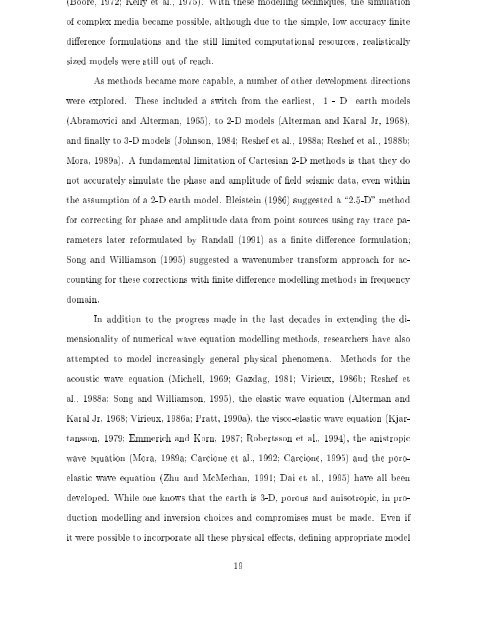Frequency domain seismic forward modelling: A tool for waveform ...
Frequency domain seismic forward modelling: A tool for waveform ...
Frequency domain seismic forward modelling: A tool for waveform ...
Create successful ePaper yourself
Turn your PDF publications into a flip-book with our unique Google optimized e-Paper software.
(Boore, 1972; Kelly et al., 1975). With these <strong>modelling</strong> techniques, the simulation<br />
of complex media became possible, although due to the simple, low accuracy nite<br />
dierence <strong>for</strong>mulations and the still limited computational resources, realistically<br />
sized models were still out of reach.<br />
As methods became more capable, a number of other development directions<br />
were explored. These included a switch from the earliest, 1 - D earth models<br />
(Abramovici and Alterman, 1965), to 2-D models (Alterman and Karal Jr, 1968),<br />
and nally to 3-D models (Johnson, 1984; Reshef et al., 1988a; Reshef et al., 1988b;<br />
Mora, 1989a). A fundamental limitation of Cartesian 2-D methods is that they do<br />
not accurately simulate the phase and amplitude of eld <strong>seismic</strong> data, even within<br />
the assumption of a 2-D earth model. Bleistein (1986) suggested a \2.5-D" method<br />
<strong>for</strong> correcting <strong>for</strong> phase and amplitude data from point sources using ray trace parameters<br />
later re<strong>for</strong>mulated by Randall (1991) as a nite dierence <strong>for</strong>mulation;<br />
Song and Williamson (1995) suggested a wavenumber trans<strong>for</strong>m approach <strong>for</strong> accounting<br />
<strong>for</strong> these corrections with nite dierence <strong>modelling</strong> methods in frequency<br />
<strong>domain</strong>.<br />
In addition to the progress made in the last decades in extending the dimensionality<br />
of numerical wave equation <strong>modelling</strong> methods, researchers have also<br />
attempted to model increasingly general physical phenomena.<br />
Methods <strong>for</strong> the<br />
acoustic wave equation (Michell, 1969; Gazdag, 1981; Virieux, 1986b; Reshef et<br />
al., 1988a; Song and Williamson, 1995), the elastic wave equation (Alterman and<br />
Karal Jr, 1968; Virieux, 1986a; Pratt, 1990a), the visco-elastic wave equation (Kjartansson,<br />
1979; Emmerich and Korn, 1987; Robertsson et al., 1994), the anistropic<br />
wave equation (Mora, 1989a; Carcione et al., 1992; Carcione, 1995) and the poroelastic<br />
wave equation (Zhu and McMechan, 1991; Dai et al., 1995) have all been<br />
developed. While one knows that the earth is 3-D, porous and anisotropic, in production<br />
<strong>modelling</strong> and inversion choices and compromises must be made. Even if<br />
it were possible to incorporate all these physical eects, dening appropriate model<br />
19

















